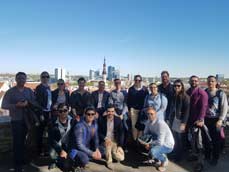EFORT Spring Travelling Fellowship in Estonia: A short report

This year’s EFORT Travelling Fellowship took place in Tartu and Tallinn, Estonia from 12 to 18 May 2019. Twelve participants from Europe were given the opportunity to interact, visit local hospitals and take part in lectures on everything from highly specialized trauma to ortho-geriatrics.

As the Swedish representative, I had the opportunity to visit Estonia under EFORT’s wing and it was an exciting experience. After arriving in Tallinn, we journeyed directly to Tartu on Sunday where there was a common course dinner in the evening. The colleagues consisted of doctors under specialist training and new specialists from England, Holland, Lithuania, Malta, Portugal, Romania, Switzerland, Slovenia, Spain, Turkey and Ukraine.
Monday was spent mainly at Tartu University Hospital with an introduction to the health care system in Estonia and plenty of lectures, the most memorable of which was the discussion about how ortho-geriatrics emerged and the fine collaboration that exists between orthopaedists and geriatricians in Estonia, as well as other European countries.
It was possible to see orthopaedists in their natural environment in the OR. Some opted to perform ACL repair and arthroscopic procedures, while others participated in knee and hip arthroplasty surgeries. As a Swede, it was interesting to see the lack of doors between operating theaters and how it was completely natural for 14 people to be in the same OR.
Tuesday was structured in a similar way, but also gave us the opportunity to give presentations about our hospitals, countries and ourselves. It was instructive to note the differences in health care culture and the construction of the health care systems, but it was also clear how similar they are to ours. The evening was spent in the center of Tartu, which is a student city in the same spirit as Lund and Uppsala in Sweden.
On Wednesday, we took a train to the capital, Tallinn, and visited Northern Estonia Medical Centre, a regional hospital. This newly built hospital exhibited an elegant flow of elective and acute patients in and around the surgical ward. As Estonia is a small country, most highly specialized cases are taken care of here. Among the lectures, it was interesting to learn about the hospital’s large bank of successful cases of nailed shoulder fractures and their experiences with arthroscopy to repair distal radius fractures. The dinner offered a beautiful view of the Gulf of Finland.
Thursday was spent at the somewhat older East-Tallinn Central Hospital. The lecturers were experienced trauma surgeons and the theme was spine fractures, as well as pseudo-arthrosis and severe cases. The latter lecture put water on the AO mill, and beautifully illustrated how mechanics and biology interact in fracture healing. Many helpful tips were discussed. The afternoon and evening were spent with a guide in the old town, which was beautiful and full of history.
On Friday, the bus took us to Lahemma National Park, where the Swedish nature was recognized. We walked through a marsh, which has a portal to the underground that has great historical significance for Estonians.
As a new specialist, this was a rewarding experience that was well organized and included interesting hospital visits and lectures. What I will take-away from this time is the personal exchanges with colleagues from all over Europe. We can learn so much from each other’s similarities and differences. Exchanges of this kind feel like an important part of both personal and professional development.
- For more information:
- EFORT Fellowships Programs


